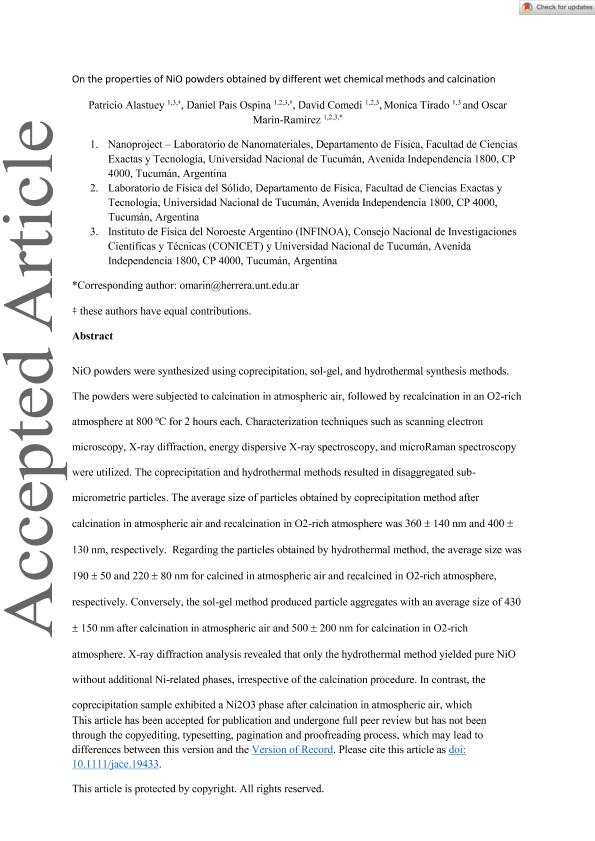Artículo
On the properties of NiO powders obtained by different wet chemical methods and calcination
Alastuey, Patricio ; Pais Ospina, Daniel Humberto
; Pais Ospina, Daniel Humberto ; Comedi, David Mario
; Comedi, David Mario ; Tirado, Monica Cecilia
; Tirado, Monica Cecilia ; Marín Ramírez, Oscar Alonso
; Marín Ramírez, Oscar Alonso
 ; Pais Ospina, Daniel Humberto
; Pais Ospina, Daniel Humberto ; Comedi, David Mario
; Comedi, David Mario ; Tirado, Monica Cecilia
; Tirado, Monica Cecilia ; Marín Ramírez, Oscar Alonso
; Marín Ramírez, Oscar Alonso
Fecha de publicación:
09/2023
Editorial:
Wiley Blackwell Publishing, Inc
Revista:
Journal of the American Ceramic Society
ISSN:
0002-7820
Idioma:
Inglés
Tipo de recurso:
Artículo publicado
Clasificación temática:
Resumen
NiO powders were synthesized using coprecipitation, sol-gel, and hydrothermal synthesis methods. The powders were subjected to calcination in atmospheric air, followed by recalcination in an O2-rich atmosphere at 800°C for 2 h each. Characterization techniques, such as scanning electron microscopy, X-ray diffraction, energy dispersive X-ray spectroscopy, and microRaman spectroscopy, were utilized. The coprecipitation and hydrothermal methods resulted in disaggregated submicrometric particles. The average size of particles obtained by the coprecipitation method after calcination in atmospheric air and recalcination in an O2-rich atmosphere was 360 ± 140 nm and 400 ± 130 nm, respectively. Regarding the particles obtained by the hydrothermal method, the average size was 190 ± 50 and 220 ± 80 nm for calcined in atmospheric air and recalcined in O2-rich atmosphere, respectively. Conversely, the sol-gel method produced particle aggregates with an average size of 430 ± 150 nm after calcination in atmospheric air and 500 ± 200 nm for calcination in an O2-rich atmosphere. X-ray diffraction analysis revealed that only the hydrothermal method yielded pure NiO without additional Ni-related phases, irrespective of the calcination procedure. In contrast, the coprecipitation sample exhibited a Ni2O3 phase after calcination in atmospheric air, which disappeared after recalcination in an O2-rich atmosphere. The sol-gel-derived sample maintained a Ni phase after both calcination processes. Analysis of the crystallite size demonstrated an increase after recalcination in an O2-rich atmosphere for the hydrothermal and sol-gel-derived samples, while a decrease was observed for the coprecipitation-derived sample. Raman spectra exhibited defect-enabled first-order forbidden phonon modes that were sensitive to the synthesis route. The two magnon phonon modes also demonstrated dependency on the route, indicating variations in defect structures. Photocatalytic evaluation using methylene blue degradation in aqueous solutions indicated better performance for the powders recalcined in an O2-rich atmosphere.
Archivos asociados
Licencia
Identificadores
Colecciones
Articulos (INFINOA)
Articulos de INSTITUTO DE FISICA DEL NOROESTE ARGENTINO
Articulos de INSTITUTO DE FISICA DEL NOROESTE ARGENTINO
Citación
Alastuey, Patricio; Pais Ospina, Daniel Humberto; Comedi, David Mario; Tirado, Monica Cecilia; Marín Ramírez, Oscar Alonso; On the properties of NiO powders obtained by different wet chemical methods and calcination; Wiley Blackwell Publishing, Inc; Journal of the American Ceramic Society; 107; 1; 9-2023; 92-106
Compartir
Altmétricas



